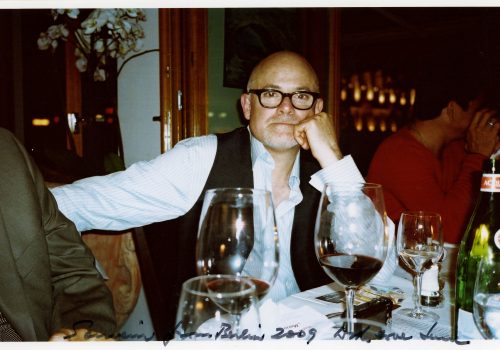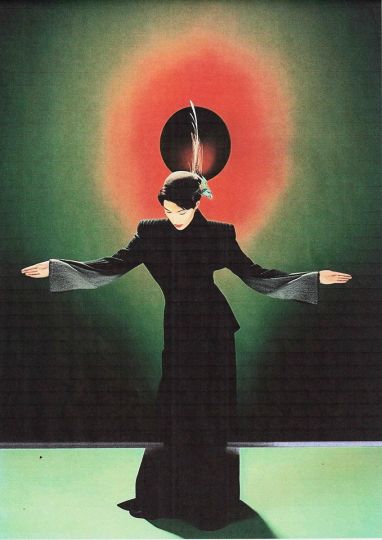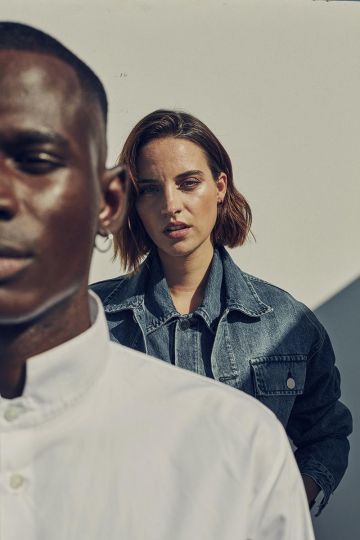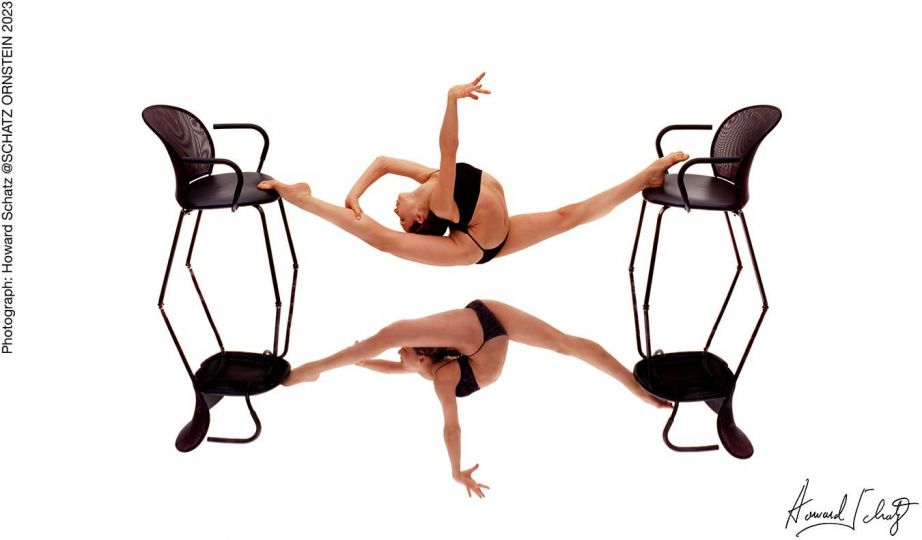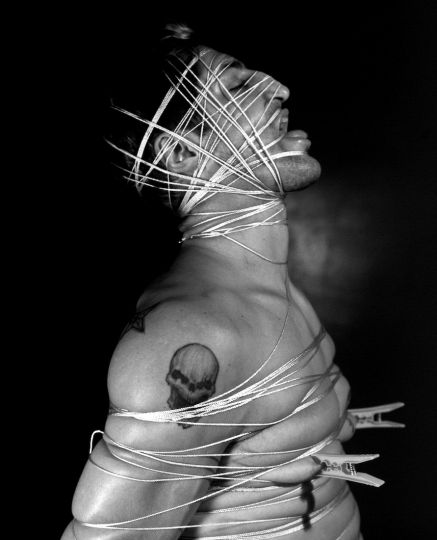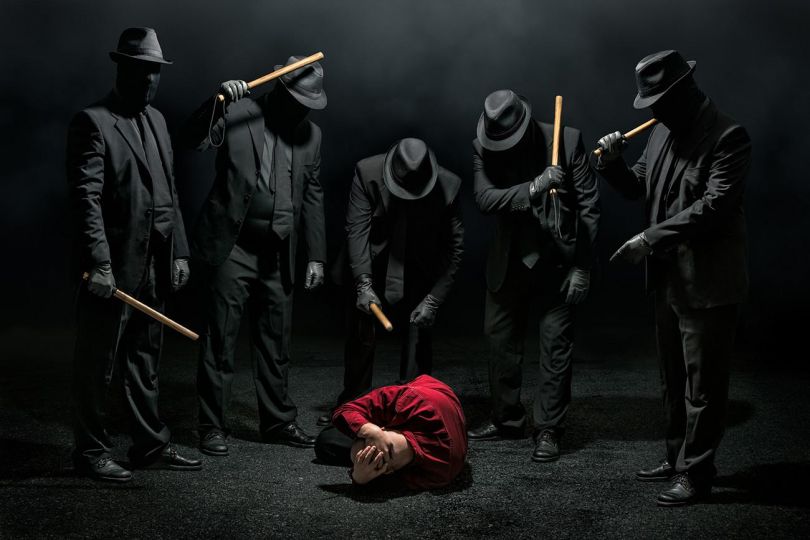George Holz counts among the very few classic Hollywood star photographers still around. After studying at the Art Center College of Design, he became one of the “disciples” of Helmut Newton, first as an assistant and then as one of the “Three Boys from Pasadena”. After stints in Paris and Milan, Holz settled down in New York City, founded his studio, and joined the who’s who of portrait & celebrity photographers of the 1990s and 2000s. From Madonna, Angelina Jolie, and Jennifer Aniston to Brad Pitt, Joaquin Phoenix, and Jack Nicholson to Jada Pinkett-Smith, Mariah Carey, and Britney Spears – Holz has portrayed them all. Later, he moved upstate where he has focused more on his fine art nudes.
To trace and track this eventful life, we got together with George Holz to discuss his highlights and find out what’s new?
Nadine Dinter: Born in Tennessee, you studied in California and spent some years in Europe, before settling down in New York City. You got your first camera as a gift at the age of 15 – shortly after that, one of your first portraits was published in People magazine. Back then, did you ever think that you would become such a famous photographer and spend your life working as one?
George Holz: When I was a boy, I never dreamed about making a career as a photographer, much less a famous one. But I remember being truly mesmerized the first time I saw an image come to life in the developing tray in a high school photography class. I became obsessed with all things photography! And yes, I knew then that this is what I wanted to do.
That was before the internet, so seeing great photography meant looking at Life Magazine and National Geographic when they came in the mail. I’d ride my bicycle down to the local five-and-dime store and use the money I’d earned from my newspaper route to buy PHOTO. That’s where I first saw the imagery of Helmut Newton, David Bailey, David Hamilton, and others. I also found hidden issues of my father’s Playboy. It was in these magazines that I realized that people could actually make a living photographing beautiful women.
ND: At the Art Center College of Design in Pasadena, California, you studied Photography, was one of your professors Helmut Newton? What did you first think of him, and what happened between that moment and when you became Newton’s assistant?
GH: A lot of people assume I studied with Helmut, but he was not actually a professor at Art Center.
The first time I met Helmut was in the basement of a store called Lina Lee on Rodeo Drive. Mark Arbeit had done some photos for the owner, Lina, and she told Mark that Helmut would be coming to pick up a check for some work he had done for Fendi.
We stayed in the basement all day waiting. He finally arrived in the evening. I was a bit star struck, nervous, and intimidated. After some small talk, we awkwardly let him know we would be happy to be his assistants, drivers or whatever, and he said, “Well, you could start by giving me a ride back to the hotel.” I had an old 1969 Dodge Dart. The passenger seat was so broken I had to prop it up with a milk crate so it wouldn’t fall back. The trunk opened with a fork. The muffler was rusted, so it had this loud, muscle-car sound. We dropped him off at the Beverly Hills Hotel where he and June were staying. Helmut just loved it when we would pull up to the valet in the company of Ferraris, Maseratis, and Rolls-Royces.
A few days later we came back and tried to get hold of him through the front desk. We left many messages. I guess you would call that “stalking” today.
Finally, Mark, Just, and I camped outside his hotel room at the Beverly Hills Hotel. We knocked on their door and June opened it, saw us, then slammed it shut. She yelled to Helmut, “They’re still here!” He opened the door and advised us to leave but return in the morning of the following day. We were persistent and it payed off. The rest is history.
ND: For a while, you were called one of the “Three Boys from Pasadena” – who gave you this nickname and who else was part of this trio?
GH: June Newton gave us the “Three Boys from Pasadena” nickname. It was Mark Arbeit, Just Loomis, and myself. We were all students and good friends at Art Center, and all worked as Helmut’s assistants. Years later, Just and I were having lunch with June at Mel’s Diner on Sunset Strip. She presented the idea of having our inaugural show at the Helmut Newton Foundation, and said, “I’m going to call you the ‘Three Boys from Pasadena.’” Later, my wife wondered if June may have been influenced by the famous Martin Munkácsi photograph, “Three Boys at Lake Tanganyika” for the name. Helmut was very influenced by his hero Munkácsi growing up in Berlin, and used to hide and watch him take his camera bags out of his car at the same garage where the Newton’s also kept their car.
ND: The story goes that you first worked as one of Newton’s assistants, and then later you became a true friend of Helmut and June Newton. Which photo shoots did you assist him with – are there any anecdotes about this time you could share with us?
GH: Some of the most memorable shoots I worked with Helmut on include the famous album cover shoot for Van Halen with lead singer David Lee Roth, the Stern Magazine fashion shoots, and a portrait session with body builder Lisa Lyon.
On the Van Halen shoot, Rick Seireeni, Creative Director at Warner Bros Records, sent me to McDonalds with a $100 bill and told me to buy as many Big Macs as I could get. Helmut loved all things “Americana.” I artfully tied David Lee Roth up in chains for the iconic portrait of him. I still recall taking light readings for the portrait he did of Eddie Van Halen—who sadly passed away recently.
On one of the Stern Magazine shoots, Helmut and fashion editor Florentine Pabst had Mark and I canvassed Manhattan Beach for surfers. We told them they would be posing for a magazine with beautiful models for a famous photographer, and they would each get $20.
Lisa Lyon was the muse-du-jour in fine art circles, everyone was inspired by her, including Mapplethorpe. Helmut’s photos of her were powerful and provocative. Years later, I had the opportunity to photograph Lisa myself. It was a great experience.
In 1991, about 10 years after I’d stopped assisting Helmut, he and June came to my exhibition at G. Ray Hawkins Gallery in LA. I was so proud showing them my show of nudes, and they were both very complimentary. They were like my second parents.
June would continue to come to LA and stay at the Chateau Marmont in the years after Helmut’s death. We’d often meet and have drinks or dinner when I was in LA on business. I remember I was editing photos for my Holz Hollywood: 30 Years of Portraits, and showing her some of my choices. She looked at my photo of Jack Nicholson, and commented, “Oh, these are much better than Helmut’s photos of Jack!” When she came to a very sexy photo of Javier Bardem, she yelled out in the restaurant, “This is the sexiest photo of a man I’ve ever seen— it just makes you want to have sex with him!” Never a dull moment with June.
ND: What was the tipping point when you took Newton’s advice to move to Europe and start your own career? Where did you live, for how long, and what did you experience and work on during these years?
GH: I assisted Helmut during my last year at Art Center. That was a golden era. Sometimes after shoots we’d hang around the Polo Lounge at the Beverly Hills Hotel, and I’d show Helmut my photographs –– he was critical, honest, and encouraging. After graduating in 1980, I was itching to start shooting on my own. I loved working with Helmut, but felt it was time to leave the nest. He advised me to start in Milan.
Several months later Mark Arbeit and I moved into a small apartment called the “Residence Glory” in Milan. It had very little heat, but the building had a model agency on the top floor which allowed us to test shoot in our apartment and around town. Helmut had scribbled a few names of magazines and people to see, but it took nearly 6 months of knocking on doors and being very persistent in my broken Italian to get my first job—shooting some still-lifes of shoes for Donna. We lived hand-to-mouth, from one job to the next, doing our billing through a local modeling agency that took a very high percentage –– but it gave us desperately needed cash. Eventually I got some beauty and fashion jobs from Mondadori’s 100 Cose and Linea Italiana.
From there, I segued into shooting beauty and fashion for Franca Sozzani at Lei and for Carla Sozzani at Vogue Italia (special editions). The Sozzani sisters were an amazing force-of-nature at Condé Nast Italia, I’m so fortunate to have had their creative influence so early in my career. It was great sharing the same studios and magazine pages with photographers like Herb Ritts, David Bailey, Steve Hiett, and Steven Meisel. On one Vogue Sposa story, I worked with the young Catherine Dyer Bailey.
I started going to Paris, working for Elle, L’Officiel, and Madame Figaro. It was great shooting editorial with some of Helmut’s favorite models like Violetta Sanchez, Tara Shannon, Jassara, and Robin Osler.
ND: When you returned to New York in 1983, one of the major jobs you scored was the photo shoot for Madonna’s Borderline album. How did you both meet? What was the collaboration like?
GH: In 1983, I was living in Milan and Paris, but traveling to New York and Los Angeles for assignments.
My longtime Art Center friend Jeri Heiden, Creative Director at Warner Bros Records, called to ask if I’d be interested in photographing an up-and-coming young artist named Madonna. She had a few singles out at the time, but not many photos, so they were looking to get some new images to use for publicity and promotion. I had already heard some buzz about her, loved her name, and figured she could be amazing to shoot.
I met Madonna at the rather dilapidated Chateau Marmont Hotel in Hollywood, which, at that time, was Hollywood’s equivalent of New York’s Chelsea Hotel.
She invited me up to her funky bungalow room where she had all her clothes laid out on the bed: lots of black, leather, chains, crucifixes, and hats. I was in heaven. We chose our favorite things, then walked down Sunset Blvd. to a nearby small basement studio I had rented from a friend. Madonna helped carry a few pieces of my equipment. No one recognized us as we walked down the street.
I shot with my Hasselblad for about 2 hours, in color and black-and-white. She was pretty low-key in person, but came alive in front of the camera: energetic, sexual, charismatic, and incredibly photogenic. I was using some of the lighting and motion techniques I’d developed shooting editorials for Lei and Mademoiselle. The image of her dancing to “Lucky Star” as the cassette blasted on the boom box is forever etched in my memory. My own personal Madonna concert!
The resulting photographs were used for the special Borderline 12” single, the Madonna: First Album cover art, as well as a feature in Interview Magazine. They were a timeless documentation of the nascent part of her career. I had no idea they’d become so iconic.
ND: You have always worked between editorials and advertising, including a number of prestigious campaigns for DeBeers, Elisabeth Arden, and Bloomingdales, followed by countless album covers for Shania Twain, Mariah Carey, Van Halen, Suzanne Vega, and Boys II Men. Did any of those jobs lead to lasting relationships? Would you say that your photographic style/approach was influenced in some way by Helmut Newton – who called himself a “manipulator”?
GH: Yes, I’ve been fortunate to have worked with some truly great clients over the years, many of whom I’ve worked with multiple times. Art directors and photo editors typically move to different companies, the best remain loyal even when they move on. Some of the greats I’ve had opportunity to work with are Laurie Kratochvil—Rolling Stone and InStyle, Chris Dougherty—Premiere and New York magazine, Helmut Schmidt—Harper’s Bazaar, Jodi Peckman—FHM and Rolling Stone, and Allyson Torrisi—Mens’ Journal and People.
I worked with the legendary Creative Director John Jay on some very influential campaigns with Bloomingdales. I did many of Shania Twain’s biggest albums for many years. Mariah Carey and I collaborated on many shoots and albums together, including Glitter, which made a big comeback this year. I’ve done 4 different album covers for Suzanne Vega, including the Grammy winning Days of Open Hand. I recently shot her latest album, An Evening of New York Songs and Stories, which we shot at the Carlyle just before the Covid lockdown.
I worked with John Travolta on multiple movie posters, and have photographed the lovely Andie MacDowell and her family on many occasions. The same with Nicolas Cage. I continue to photograph Hanes campaigns with the legendary Michael Jordan aka MJ. It’s nice when celebrities request you.
I definitely think my work has been influenced by Newton, especially my early work. I was also influenced by Man Ray, Irving Penn, Guy Bourdin, Edward Weston, and others. A style develops when you take your influences, and you just shoot a lot—over the years your personal style will evolve.
As for being a manipulator? Yes, technically at least, all photographers are manipulators, although I’d qualify that a bit because I don’t manipulate people. I manipulate light, setting, and mood to create a space for expression, and that expression has to come from a collaboration between me and the subject. For myself, I prefer the word trust. Technique is merely supportive. Trust is what allows us to see into the soul of a subject, and that must be earned.
ND: In recent years, you have done more nudes and portraits, staging them close to the Holz Farm in upstate New York near the Catskills. How has this change of scenery affected your work?
GH: I’ve been lucky in my career to travel around the world shooting at beautiful and exotic locations –– but to me, the most beautiful place to shoot is our home in the Catskill Mountains of upstate New York. What started off as an escape from the busy studio life of New York City in the late 1980’s, has ended up being a godsend during this time of the Covid lockdown.
Camp Holz is a series of nudes I started circa 1988 at my property in the Catskills. Here, the light is constantly changing—the same light that inspired the great artists of the Hudson River School. I love to juxtapose flora, fauna, and structures while photographing friends, artists, dancers, writers, and muses.
We live off the land here—eating the trout I catch in the streams, the deer I hunt in the mountains. We make our own apple cider and maple syrup. There is something very satisfying about planting a peach tree, harvesting the fruit, and using it as an amazing canvas for a photograph.
Shooting here is a calming influence and welcome respite from the bustling energy of editorial and advertising. It allows me to slow down and intimately observe my surroundings, the light, and my subjects in a more relaxed setting. This slowed time and familiarity allow a level of depth and complexity.
ND: You visited Berlin a few times in the past and did some memorable shots at the famous Hotel Bogota, where Newton studied photography at Yva’s studio, and also at Pension Funk. What was it about those old hotels that inspired you – and what makes a good nude photograph?
GH: I have a magnetic and nostalgic attraction to these Berlin Hotels. Perhaps they remind me of what my grandmother’s house in Potsdam must have looked like in the 1930’s before they were forced to flee Nazi Germany. I think of my father wandering those same streets in Berlin as a boy, before he had to leave, almost the same year Helmut did. My father was born in 1921, Helmut in 1920. There is something oddly familiar about Berlin for me, like a déjà vu –– it’s hard to explain.
The Bogota always had an obvious attraction because of the Newton connection. You can just feel the presence of Yva and Helmut there. It’s like shooting in a museum. June booked us rooms there for our first “Three Boys” show in 2009, and I always stayed there until it was sold a few years ago. The owner, Joachim Rissman, curated the hotel so beautifully, and he always let me stay in and photograph all the best rooms. I’ve had many memorable shoots there starting with the Anna series during the time of our first show at the HNF, and the intimate and iconic photos you and I did together, and lastly the photos of Sylvia Gobbel, one of Newton’s all-time favorite muses. The Bogota will always hold a special place in my heart. It’s sad to walk by there today. The only memory left is the “Stolperstein” or stumbling stone, inscribed with Yva’s name on the sidewalk in front of where the hotel once stood.
I stayed and photographed at the wonderful Hotel-Pension Funk on my last trip to Berlin. It has this wonderful Art Nouveau and Belle Époque vibe to it. I tried to stay in the different rooms so I could photograph them all!
I love the beautiful soft light that comes in the windows, the old wallpaper, and the dark wood furniture. These hotels have always been like studios away from home for me. A great place to work and shoot when you’re on the road. I must have inherited Helmut’s fascination of shooting in hotels.
ND: What are your next projects and what is your advice to the next generation of photographers?
GH: I’m currently working on a book of my nudes. It’s a retrospective encompassing 40 years. The working title is HOLZ NUDE. Dr. Matthias Harder, curator of the Helmut Newton Foundation in Berlin, will be writing the text for the book.
A second and revised edition of Holz Hollywood: 30 Years of Portraits is possibly in the pipeline. The first edition is now out of print.
I’m planning some future exhibitions, in Europe, The United States, and Japan—confirmation and dates pending due to Covid unpredictability. I miss traveling.
We were able to hold our annual masterclass at The Holz Farm, Portraits of Wilderness and the Human Form, this past August. While many other photo workshops were canceled or held virtually due to Covid, we managed to safely do ours. We’re currently planning next year’s classes.
I’m continuing to do commercial assignments, which are slowly coming back after the initial Covid lockdown. The quarantine period has forced me to reevaluate and reinvent, which is always important as a photographer. I’m still doing privately commissioned portraits, and have been experimenting with shooting remotely as well.
And lastly, I’m constantly shooting new sessions for the Camp Holz series.
I’m lucky to have done a lot of teaching, both on a university level and through workshops, where I get to talk to and meet a lot of young photographers.
My advice? Practice the craft of photography! Get in a studio and learn lighting, get in a darkroom and learn how photographs are made. Experiment with available light, mix light, and try things outside your comfort zone. Most importantly, shoot, shoot, and shoot more! Everyone is constantly bombarded by imagery today. I advise young photographers not to shoot just for Instagram gratification, but look at the bigger picture.
Thank you, George for this truly cool interview!
For more information on George Holz, please visit: https://www.georgeholz.com/ or follow him on instragram at @georgeholzofficial

